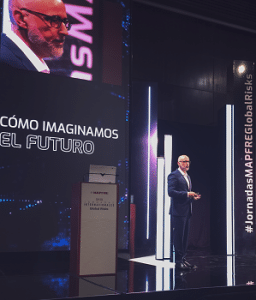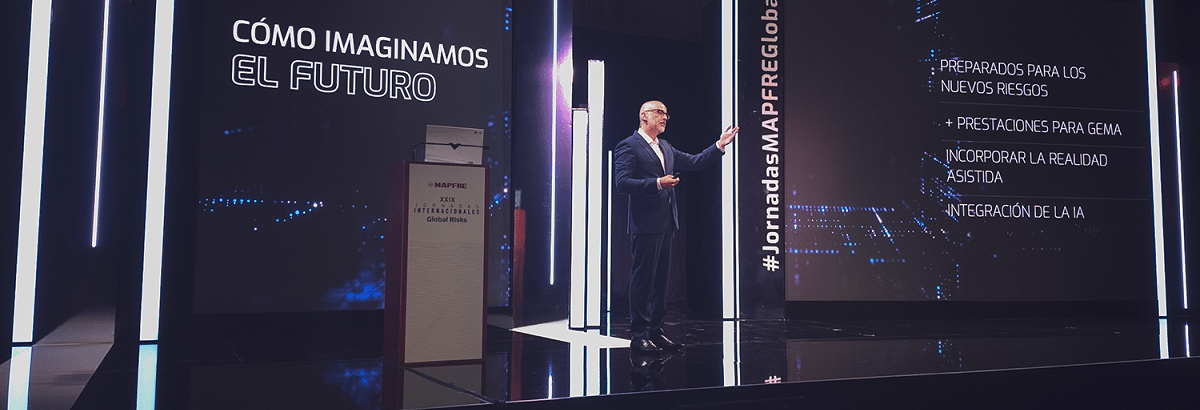Cristina Leon Vera | 03/09/2024
In the last five years, the Engineering Area at MAPFRE Global Risks has been transformed to provide a comprehensive, innovative, and effective service to the company’s customers. Over the course of this journey—as Óscar Estrada defines it—innovation has played a prominent role.
The Engineering Area was a key participant in MAPFRE’s International Global Risks Seminar, held in Málaga, with a presentation by Óscar Estrada, Engineering Services Manager. Estrada presented two cutting-edge tools to the audience. First, GEMA, a management system that streamlines the flow of information between the broker, customer, and insurance company. Then, MGR Remote, a new remote inspection model with a high-level security protocol. But the first step in achieving these developments, the expert noted, was to analyze interactions with customers, brokers, and reinsurance partners in the ecosystem. From this starting point, they embarked on a journey to optimize operations and bring innovation to internal processes, involving customers as partners in this effort through surveys, meetings, and so on.
As a result of this exploratory work, the team specified four vectors to guide the Area’s transformation:
- Information management: through traceability that is robust and accessible to all parties involved.
- Faster response times in customer requests.
- Better communication capacity.
- And finally, the incorporation of other services, along with the recommendations made.
This gave rise to their value proposition, which they named “Account Engineering Service” and which is supported by the two above-mentioned technologies, detailed as follows:
GEMA: a quantum leap in communication and service
 As Estrada explained, GEMA is based on the four points mentioned above. First, “it improves management of the information that will reach our customers. This is because it’s more traceable and consistent for all users while reducing access time.” You can log in and view the improvement plans immediately, because “GEMA was designed to be a self-service tool that customers can use without the engineer’s intermediation.” It also brings a new communication channel that replaces the usual channel, email, “which allows us to establish a dialog with the plants or with our customer’s risk managers and generate more value.”
As Estrada explained, GEMA is based on the four points mentioned above. First, “it improves management of the information that will reach our customers. This is because it’s more traceable and consistent for all users while reducing access time.” You can log in and view the improvement plans immediately, because “GEMA was designed to be a self-service tool that customers can use without the engineer’s intermediation.” It also brings a new communication channel that replaces the usual channel, email, “which allows us to establish a dialog with the plants or with our customer’s risk managers and generate more value.”
The tool digitizes recommendation reports and improvement plans, which can be viewed at any time. In addition, Estrada points out: “Customers can add notes and comments, providing input that allows us to develop plans without having to wait for a future visit from our engineers. This tool keeps the improvement plan alive.”
Another vital aspect is security, a decisive factor in the entire process. GEMA was developed in a specific environment designed for MAPFRE in Amazon Web Services, with the involvement of the company’s IT department. “Security ensures that neither our systems nor our customers’ systems are compromised, and that we can work in a secure environment.”
He also highlighted its accessibility. GEMA makes it possible for all facilities with improvement plans to be automatically geo-referenced and to know whether the plan is up-to-date or not. “This may not seem important, but it is. When we’re working on a renewal, we need to have accurate data on how the improvement plans are progressing,” Estrada emphasized.
The customer can send comments directly to the head engineer and attach files to verify that the improvement has been made: videos, photos, or any other documentary proof. Using the application, these resources can be downloaded at any time. In short, “GEMA is a leap forward in our service capacity and will be of great help to our customers.”
MGR Remote: optimizing time and resources
Another tool that the Area has been using for some time is MGR Remote, which is designed to carry out virtual remote inspections. According to the expert, it’s a “hybrid inspection” tool that has expanded its capabilities in this area. It acts in the cloud and follows the same security protocol as GEMA, with access through a secure authentication system.
Estrada describes the experience as “positive and very enriching,” since “the use of this platform has enabled remote inspection visits, while supporting very dynamic and fluid communication with customers that involves exchange of information in real time. You barely have to leave your workstation, which eliminates geographical barriers.”
One of the advantages for the customer is how it optimizes their time, a benefit also enjoyed by risk engineers. Its impact is also quite positive in economic terms, but also productivity and, of course, sustainability. “The use of this tool has decreased travel, which sometimes involved long trips, as much as possible, so resources are managed more efficiently,” he adds.
 Engineers are also reaping other benefits from the tool, especially in terms of opportunities for learning and knowledge transfer. They can contact engineers working in other locations, as well as experts from the Engineering Area. According to Estrada, this makes it possible to “carry out a more accurate and higher-quality technical diagnosis and risk assessment.”
Engineers are also reaping other benefits from the tool, especially in terms of opportunities for learning and knowledge transfer. They can contact engineers working in other locations, as well as experts from the Engineering Area. According to Estrada, this makes it possible to “carry out a more accurate and higher-quality technical diagnosis and risk assessment.”
Next destinations on the Engineering Area’s journey
The MAPFRE Global Risks Engineering Area will continue its journey in the coming years, with new destinations ahead. For instance, Estrada mentioned making an inventory of risks related to the energy transition. The team also wants to continue to improve GEMA, “so that it has even more capacity to generate value for the customer in an autonomous way.”
Moreover, they have already taken their initial steps in assisted reality. This technology, which allows information to be associated with an image, is already available, but “the idea is to incorporate it into our processes and operations, so that when I visit a facility and take a photo of a piece of equipment, there is valuable background information for making new recommendations.” Finally, they also want to explore how artificial intelligence can improve their engineering processes, and “we’ll certainly find a place for it,” he concludes.
Here’s a video of Óscar Estrada’s presentation “Innovation in Engineering Services.”





